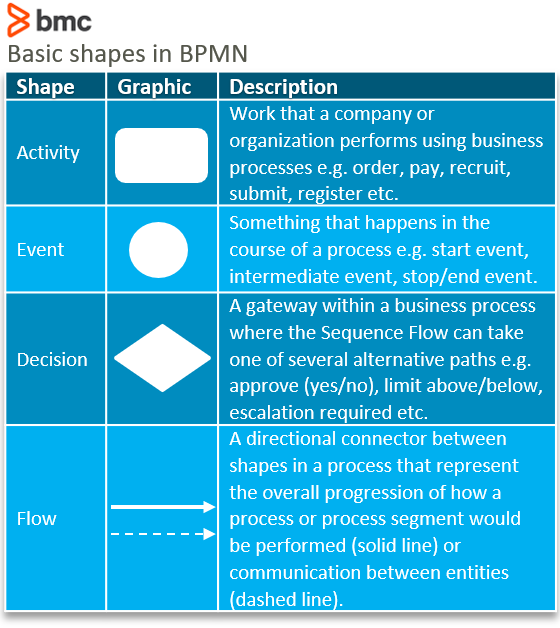When it comes to improvement, businesses around the world have pinpointed value streams and processes as low hanging fruit. You can analyze the steps taken to transform inputs, such as demand, into outputs, such as products and services, based on participants, resources, effort, cost, time, and other aspects to identify opportunities to enhance effectiveness and efficiency.
Once of these visualization techniques—Business Process Modeling Notation—is a popular standard. Let’s take a look at BPMN, including:
- A brief history
- Basic and advanced techniques
- Best practices
Why use visualization?
Writing for HBR, Scott Berinato stated that complex systems—business process workflows, for example, or the way customers move through a store—are hard to understand, much less fix, if you can’t first see them. Visualizing activities provides significant benefit in terms of:
- Better comprehension across the organization
- Ease of spotting bottlenecks and other constraints
- Identification of optimization and automation opportunities
Visualization has been around for many years, with the most popular standards evolving to support business processes, particularly in the digital age. Some popular visualization standards include:
- Business Process Modeling Notation (BPMN)
- Unified Modeling Language (UML)
- Decision Model and Notation (DMN)
Interestingly, these three standards are managed by the Object Management Group (OMG) which is a non-profit consortium that develops enterprise modeling standards that enable powerful visual design, execution, and maintenance of software and other processes.
What is BPMN? The BPMN origin story
Business Processing Modeling Notation is a model and a notation that is exclusively applicable to Business Processes. Its purpose is two-fold:
- Providing businesses with the capability of understanding their internal business procedures in a graphical notation
- Facilitating the ability to communicate these procedures in a standard manner.
This enhances understanding of the performance collaborations and business transactions between members of the organization and other stakeholders, which leads to better ownership and empowerment. BPMN was primarily developed to support technical implementation of processes, i.e. process automation. As a standard, it has been applied by most process automation solution vendors.
According to Trisotech, the first version of BPMN was published in 2004 by the Business Process Management Initiative (BPMI), which merged with OMG in the following year. In 2006, OMG released a BPMN Specification document, before beginning the development of version 2.0 in 2010. BPMN v2.0 was released in 2013, and the latest version (2.0.2) was adopted by ISO as a standard through ISO/IEC 19510:2013.
Basic BPMN shapes
BPMN shapes are used to represent business processes in a standardized graphical notation. While there are many shapes as outlined in the BPMN guide, there are four main shapes that set the foundation for describing processes: activity, event, decision, and flow.
Combining these shapes brings a process to life in a visual perspective. Consider a simple process for shopping. It starts with browsing the catalogue, choosing products, making a decision to pay, and processing the payment. By using BPMN shapes, we can visualize this process as shown below:

As can be seen, the visual process is very simple yet clearly outlines the process and provides room for investigating improvements such as digitization, improving turnaround time and streamlining activities.
Additional BPMN shapes
Beyond the four basic shapes, other basic shapes include:
- Show information as an input/output to process activities, e.g. paper or digital documents.
- Show additional information that can better explain process activities.
- Graphical container for grouping activities e.g. groupings based on roles or systems used.
We can add these shapes to our original process and show data such as receipts and chat messages, artifacts such as description of challenges a customer faces, and swimlanes showing role of the customer and customer support agent, as seen below:

BPMN best practices
When it comes to BPMN, the rules are not cast in stone but there are some best practices that can be applied in the naming and layout of the process activities. For example:
- Draw from left to right (or the order of your company’s predominant language) so people can more easily understand process flow the same way as written communication.
- When naming activities, use the object-orientated design principle of using the [verb] + [object] pattern, e.g. assist customer.
- Use keywords that are common to the business context. Avoid uncommon abbreviations, articles, or pronouns.
- If a start event is used, then there must be a stop/end event.
- Aim to fit diagrams on one page.
- Ease readability by reducing crisscrossing.
BPMN provides good value for organizations wanting to document their processes in a way that is clearly understood by participants. It’s also a strong foundation for optimization and automation. Training in BPMN should be something all companies invest in to drive a culture of improvement and collaboration among employees and stakeholders involved in all areas of the business.
Additional resources
For more on business processes and visualization methods, explore these resources:







